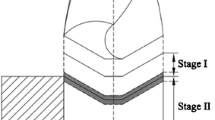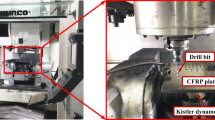Abstract
Drilling is often employed when using carbon fiber–reinforced polymers (CRFPs) to fabricate machine parts. However, CFRP drilling is compromised by uncut fibers and delamination of the final layers of fiber sheets, reducing the quality and strength of the product, increasing fatigue around drilled holes, and rendering product assembly difficult. We used a mathematical model to analyze drilling behaviors at the critical cutting angles 0 < φ ≤ \({\Upsilon }_{0}\)+π/2 and \({\Upsilon }_{0}\)+π/2 < φ. We used the Euler–Bernoulli beam theory to derive the maximum lengths of uncut fibers; these were determined by reference to half of the maximum deflection of a simply supported beam. Critical cutting angles were calculated by evaluating the hogging and sagging of a cantilever beam after fracture of a maximally deflected single fiber. These analyses were used to validate the experimental data obtained under various machining conditions, employing two tools to drill three different types of multidirectional CFRP sheets. Predictions were derived using an analytical Dexel model that employs self-generating 3D software. During simulation, the drilling tools were moved using NC-code kinematics, or manually, in the X, Y, and Z directions. The model errors for the experimental results were 2–12% in terms of the maximum uncut fiber length. The critical uncut fiber cutting windows of the predictions and experiments indicate approximately 90–95% agreement.











Similar content being viewed by others
Availability of data and materials
The authors confirm that the data supporting the findings of this study are available within the article.
References
Geng D, Liu Y, Shao Z et al (2019) Delamination formation, evaluation and suppression during drilling of composite laminates: a review. Compos Struct 216:168–186. https://doi.org/10.1016/j.compstruct.2019.02.099
Geier N, Szalay T, Takács M (2019) Analysis of thrust force and characteristics of uncut fibres at non-conventional oriented drilling of unidirectional carbon fibre-reinforced plastic (UD-CFRP) composite laminates. Int J Adv Manuf Technol 100:3139–3154. https://doi.org/10.1007/s00170-018-2895-8
Seo J, Kim DY, Kim DC (2021) Recent developments and challenges on machining of carbon fiber reinforced polymer composite laminates. Int J Precis Eng Manuf 22:2027–2044. https://doi.org/10.1007/s12541-021-00596-w
Su F, Yuan J, Sun F et al (2018) Analytical cutting model for a single fiber to investigate the occurrences of the surface damages in milling of CFRP. Int J Adv Manuf Technol 96:2671–2685. https://doi.org/10.1007/s00170-018-1797-0
Geier N, Xu J, Pereszlai C et al (2021) Drilling of carbon fibre reinforced polymer (CFRP) composites: difficulties, challenges and expectations. Procedia Manuf 54:284–289. https://doi.org/10.1016/j.promfg.2021.07.045
Yan X, Reiner J, Bacca M et al (2019) A study of energy dissipating mechanisms in orthogonal cutting of UD-CFRP composites. Compos Struct 220:460–472. https://doi.org/10.1016/j.compstruct.2019.03.090
Xu J, Li C, Mi S et al (2018) Study of drilling-induced defects for CFRP composites using new criteria. Compos Struct 201:1076–1087. https://doi.org/10.1016/j.compstruct.2018.06.051
Fu X, Kim DM (2021) Geometrical simulation model for milling of carbon fiber reinforced polymer ( CFRP ) composites. 0–29
Bhushi U, Suthar J, Teli SN (2019) Performance analysis of metaheuristics optimization techniques for drilling process on CFRP composites. Mater Today Proc 28:1106–1114. https://doi.org/10.1016/j.matpr.2020.01.091
Li W, Huang Y, Chen X et al (2021) Study on laser drilling induced defects of CFRP plates with different scanning modes based on multi-pass strategy. Opt Laser Technol. https://doi.org/10.1016/j.optlastec.2021.107400
Xu J, Lin T, Davim JP et al (2021) Wear behavior of special tools in the drilling of CFRP composite laminates. Wear 476:203738. https://doi.org/10.1016/j.wear.2021.203738
Geier N (2020) Influence of fibre orientation on cutting force in up and down milling of UD-CFRP composites. Int J Adv Manuf Technol 111:881–893. https://doi.org/10.1007/s00170-020-06163-3
Böß V, Denkena B, Breidenstein B et al (2019) Improving technological machining simulation by tailored workpiece models and kinematics. Procedia CIRP 82:224–230. https://doi.org/10.1016/j.procir.2019.04.157
Luo S, Bayesteh R, Dong Z, Jun MBG (2016) 3-axis milling algorithm development for carbon fiber reinforced polymer (CFRP) composites. 33:447–452. https://doi.org/10.7736/KSPE.2016.33.6.447
Zhaohua F, Cook RD (1983) Beam elements on two-parameter elastic foundations. J Eng Mech 109:1390–1402. https://doi.org/10.1061/(asce)0733-9399(1983)109:6(1390)
Mn M, Ti F, Kumar S et al (2010) Influence of Ti4+ doping on hyperfine field parameters of Mg0.95Mn0.05Fe2−2x Ti2x O4 (0⩽x⩽0.7). 17:1139–1143. https://doi.org/10.1007/s11771-010-0609-y
Cheng H, Zhang K, Wang N et al (2017) A novel six-state cutting force model for drilling-countersinking machining process of CFRP-Al stacks. Int J Adv Manuf Technol 89:2063–2076. https://doi.org/10.1007/s00170-016-9236-6
Díaz-Álvarez A, Díaz-Álvarez J, Santiuste C, Miguélez MH (2019) Experimental and numerical analysis of the influence of drill point angle when drilling biocomposites. Compos Struct 209:700–709. https://doi.org/10.1016/j.compstruct.2018.11.018
Jaiswal AP, Khanna N, Bajpai V (2020) Orthogonal machining of heat treated Ti-10-2-3: FE and experimental. Mater Manuf Process 35:1822–1831. https://doi.org/10.1080/10426914.2020.1802039
Timoshenko S, Woinowsky-Krieger S (1959) Theory of Plates and Shells. McGraw-Hill, New York
Wang CM (1995) Timoshenko beam-bending solutions in terms of Euler-Bernoulli solutions. J Eng Mech 121:763–765. https://doi.org/10.1061/(asce)0733-9399(1995)121:6(763)
Seeholzer L, Scheuner D, Wegener K (2020) Analytical force model for drilling out unidirectional carbon fibre reinforced polymers (CFRP). J Mater Process Technol 278:116489. https://doi.org/10.1016/j.jmatprotec.2019.116489
Guo DM, Wen Q, Gao H, Bao YJ (2012) Prediction of the cutting forces generated in the drilling of carbon-fibre-reinforced plastic composites using a twist drill. Proc Inst Mech Eng Part B J Eng Manuf 226:28–42. https://doi.org/10.1177/0954405411419128
Zhang H, Chen W, Chen D, Zhang L (2001) Assessment of the exit defects in carbon fibre-reinforced plastic plates caused by drilling. Key Eng Mater 196:43–52. https://doi.org/10.4028/www.scientific.net/kem.196.43
Xu W, Zhang LC, Wu Y (2014) Elliptic vibration-assisted cutting of fibre-reinforced polymer composites: understanding the material removal mechanisms. Compos Sci Technol 92:103–111. https://doi.org/10.1016/j.compscitech.2013.12.011
Poór DI, Geier N, Pereszlai C, Xu J (2021) A critical review of the drilling of CFRP composites: burr formation, characterisation and challenges. Compos Part B Eng. https://doi.org/10.1016/j.compositesb.2021.109155
Hintze W, Hartmann D (2013) Modeling of delamination during milling of unidirectional CFRP. Procedia CIRP 8:444–449. https://doi.org/10.1016/j.procir.2013.06.131
Niu B, Su Y, Yang R, Jia Z (2016) Micro-macro-mechanical model and material removal mechanism of machining carbon fiber reinforced polymer. Int J Mach Tools Manuf 111:43–54. https://doi.org/10.1016/j.ijmachtools.2016.09.005
Chen L, Zhang K, Cheng H et al (2017) A cutting force predicting model in orthogonal machining of unidirectional CFRP for entire range of fiber orientation. Int J Adv Manuf Technol 89:833–846. https://doi.org/10.1007/s00170-016-9059-5
Su F, Deng Z, Qiu X et al (2020) Morphological characteristics and formation mechanisms of the UD-CFRP drill exit-damages. Int J Adv Manuf Technol 107:2363–2374. https://doi.org/10.1007/s00170-020-05186-0
Funding
This work was supported by the National Research Foundation of Korea (NRF) Grant funded by the Ministry of Science and ICT (NRF-2017R1A5A1015311 and NRF-2022R1A2C3007963).
Author information
Authors and Affiliations
Contributions
AP Jaiswal designed and performed the experiments, and derived the models. HW Park contributed to the analysis of the results and writing of the manuscript.
Corresponding author
Ethics declarations
Ethical approval
The authors confirm that the content of the manuscript is original and has not been published previously and it is not under consideration for publication elsewhere.
Consent to participate
The authors voluntarily agree to participate in this research study.
Consent for publication
Its publication is approved by all authors, and, if accepted, it will not be published elsewhere in the same form in English or any other language, without the written consent of the Publisher.
Competing interests
The authors declare no competing interests.
Additional information
Publisher's Note
Springer Nature remains neutral with regard to jurisdictional claims in published maps and institutional affiliations.
Rights and permissions
Springer Nature or its licensor holds exclusive rights to this article under a publishing agreement with the author(s) or other rightsholder(s); author self-archiving of the accepted manuscript version of this article is solely governed by the terms of such publishing agreement and applicable law.
About this article
Cite this article
Jaiswal, A.P., Park, H.W. Experimental and analytical examination of multidirectional carbon fiber–reinforced polymers for uncut fibers and their distributions during drilling. Int J Adv Manuf Technol 123, 1323–1339 (2022). https://doi.org/10.1007/s00170-022-10215-1
Received:
Accepted:
Published:
Issue Date:
DOI: https://doi.org/10.1007/s00170-022-10215-1




